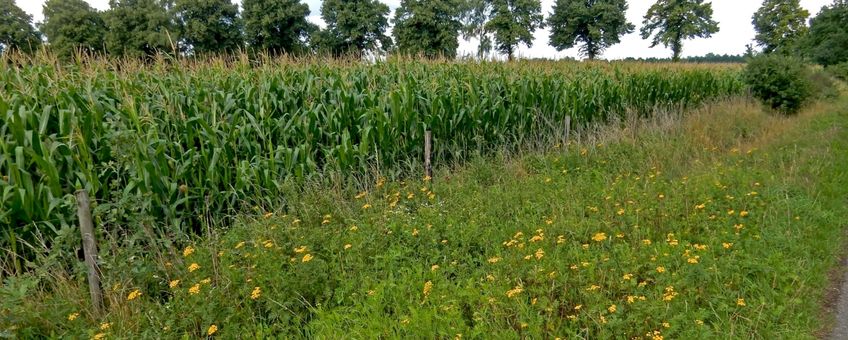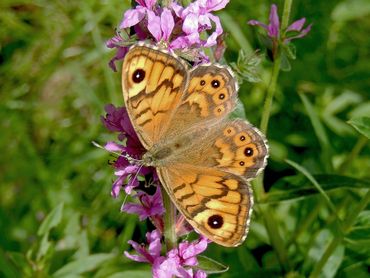
Risks of genetically modified maize for butterflies and moths in field margins
Dutch Butterfly Conservation It often remains unclear whether non pest species are present in the vicinity of crop fields, and to what extent this could pose a significant problem. Therefore, the Netherlands Commission on Genetic Modification (COGEM) asked the Dutch Butterfly Conservation (De Vlinderstichting) to compile an overview of the evidence. In many GM crops that are cultivated worldwide, insect resistance has been incorporated. These crops, such as maize, contain Bt toxins that are poisonous to certain pest insects. The toxins are produced by naturally widespread soil bacteria. They are also used as pesticides in organic farming. Through genetic modification, the capacity to produce these toxins has been built into agricultural crops. Thus, Bt-maize varieties have been developed targeting caterpillars of certain moths, the corn borers. They die when they eat from the crop. But the toxins may be dispersed to areas bordering on the fields, especially via pollen. This could pose potential risks for exposure to other, non-target moths and butterflies, if these are vulnerable to the Bt-toxin as well.
It often remains unclear whether non pest species are present in the vicinity of crop fields, and to what extent this could pose a significant problem. Therefore, the Netherlands Commission on Genetic Modification (COGEM) asked the Dutch Butterfly Conservation (De Vlinderstichting) to compile an overview of the evidence. In many GM crops that are cultivated worldwide, insect resistance has been incorporated. These crops, such as maize, contain Bt toxins that are poisonous to certain pest insects. The toxins are produced by naturally widespread soil bacteria. They are also used as pesticides in organic farming. Through genetic modification, the capacity to produce these toxins has been built into agricultural crops. Thus, Bt-maize varieties have been developed targeting caterpillars of certain moths, the corn borers. They die when they eat from the crop. But the toxins may be dispersed to areas bordering on the fields, especially via pollen. This could pose potential risks for exposure to other, non-target moths and butterflies, if these are vulnerable to the Bt-toxin as well.
 The question was which species actually occur in these neighbouring areas and could be exposed to maize pollen during their development as caterpillars. Using data on the distribution of both agricultural fields and Lepidopterans, it is now known for all species of butterflies and macro-moths in The Netherlands, which proportion of their range or population falls within a 30 metre radius of maize fields. This concerns a substantial proportion of The Netherlands: 13 percent of the land area and even 20 percent in the region of sandy soils from Pleistocene origins! The most remarkable outcome was that the species with the highest proportion of records in maize field margins (38 percent) is also one of the most threatened: the Dusky Large Blue, a species protected under the European Habitats Directive. In total, 10 butterfly species and 28 macro-moth species occurred more than expected in maize field margins and could be exposed to maize pollen during the caterpillar stage. For butterflies, an additional 9 Red Listed species may be exposed during dispersal, when they may find suitable larval habitat in maize field margins.
The question was which species actually occur in these neighbouring areas and could be exposed to maize pollen during their development as caterpillars. Using data on the distribution of both agricultural fields and Lepidopterans, it is now known for all species of butterflies and macro-moths in The Netherlands, which proportion of their range or population falls within a 30 metre radius of maize fields. This concerns a substantial proportion of The Netherlands: 13 percent of the land area and even 20 percent in the region of sandy soils from Pleistocene origins! The most remarkable outcome was that the species with the highest proportion of records in maize field margins (38 percent) is also one of the most threatened: the Dusky Large Blue, a species protected under the European Habitats Directive. In total, 10 butterfly species and 28 macro-moth species occurred more than expected in maize field margins and could be exposed to maize pollen during the caterpillar stage. For butterflies, an additional 9 Red Listed species may be exposed during dispersal, when they may find suitable larval habitat in maize field margins.
 “Given the decline of butterfly populations in The Netherlands, any addition to the existing pressures from land use may contribute to further declines and possibly leading to extinction”, says senior scientist Michiel Wallis de Vries from Dutch Butterfly Conservation. “It is therefore of vital importance to keep the surroundings of arable fields ‘Lepidoptera-friendly’, not only in relation to the possible admission of GM crops, but also seen in a broader perspective of crop protection, fertilisation and further management practices.” The insights of the study are relevant for improving environmental risk assessment, also in a European context. The report has therefore been published in English. The COGEM stresses the significance of the study in assessing the risks for Lepidopteran species and identifies, based on the research carried out by Dutch Butterfly Conservation, three butterfly species occurring in field margins that could be used in such assessments: wall brown, swallowtail and Queen of Spain fritillary. Furthermore, the COGEM notes that, in considering a possible future admission of a Bt-crop, it is advisable to compare the effects on Lepidopteran populations between both regular and alternative methods of insect pest management.
“Given the decline of butterfly populations in The Netherlands, any addition to the existing pressures from land use may contribute to further declines and possibly leading to extinction”, says senior scientist Michiel Wallis de Vries from Dutch Butterfly Conservation. “It is therefore of vital importance to keep the surroundings of arable fields ‘Lepidoptera-friendly’, not only in relation to the possible admission of GM crops, but also seen in a broader perspective of crop protection, fertilisation and further management practices.” The insights of the study are relevant for improving environmental risk assessment, also in a European context. The report has therefore been published in English. The COGEM stresses the significance of the study in assessing the risks for Lepidopteran species and identifies, based on the research carried out by Dutch Butterfly Conservation, three butterfly species occurring in field margins that could be used in such assessments: wall brown, swallowtail and Queen of Spain fritillary. Furthermore, the COGEM notes that, in considering a possible future admission of a Bt-crop, it is advisable to compare the effects on Lepidopteran populations between both regular and alternative methods of insect pest management.
Text: Kars Veling & Michiel Wallis de Vries, Dutch Butterfly Conservation
Photo's: Kim Huskens; Sergej Jansen; Kars Veling
